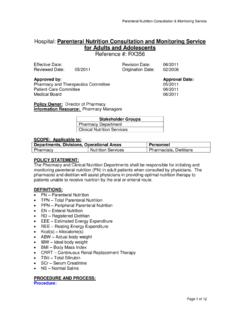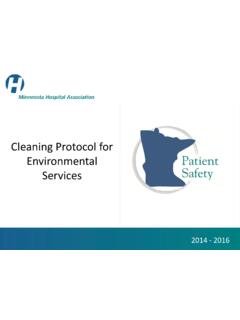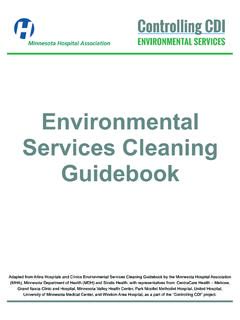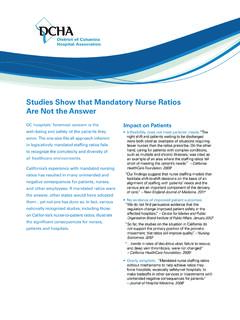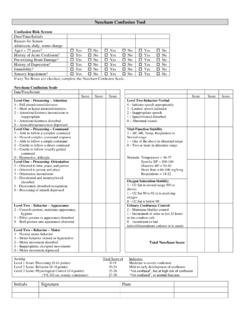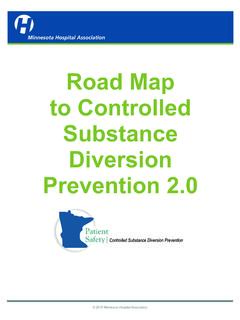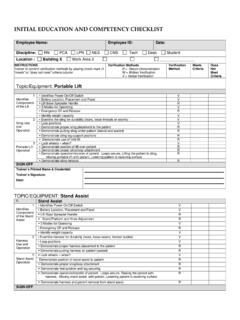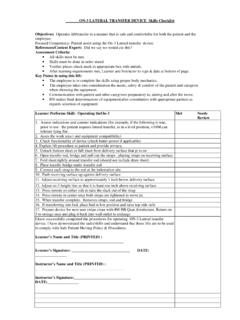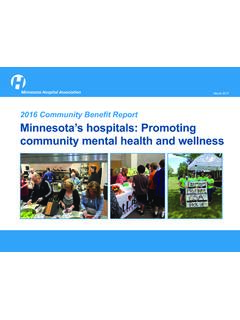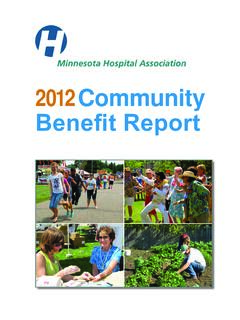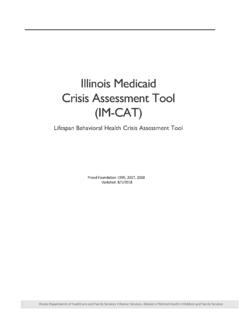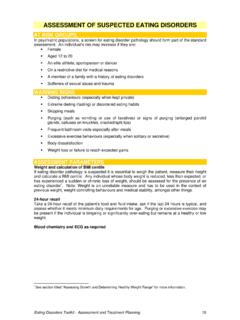Transcription of Neonatal Abstinence Syndrome (NAS) Toolkit
1 Neonatal Abstinence Syndrome (NAS) Toolkit Risk Factors, assessment and Treatment The MHA Perinatal Committee convened a work group of perinatalogists and neonatologists with the goal to better identify, screen and treat Neonatal Abstinence Syndrome (NAS). The work group developed a template for members to consider as they develop their policy and procedures. Each institution must customize their approach based on patient characteristics and needs, staff considerations and legal analysis of current Minnesota statutes. Neonatal Abstinence Syndrome (NAS) Clinical diagonsis resulting from the abrupt discontinuation of fetal exposure to licit and/or ilicitsubstances that were used by the mother during pregnancy (Kocherlakota, 2014) Rarely fatal, however withdrawl symptoms can be intense and result in longer hospital stays(Kocherlakota, 2014) Commonly associated with use of opioids, however can also be seen with use of sedatives, barbiuratesand alcohol (Tierney, 2013) Develops in 55-94 percent of infants who are exposed to these substances (Tierney, 2013)Risk Factors Associated with NAS Consider completing risk assessment screening tool when risk factors are present.
2 For the Perinatal Illicit Substance Exposure Risk assessment Tool, see appendix A (Adopted from Iowa Guidelines for Perinatal Services, Eighth Edition, Appendices, 2013) Maternal risk factors during current pregnancy Mother tested positive for use of reportable substances during this pregnancy Mother declines drug testing Current or prior illicit or unprescribed drug use including maternal self-report Altered mental status suggestive of influence and/or withdrawal from drug(s) Physical signs suggestive of drug use such as IV track marks, visible tooth decay, sores on face, armsor legs Conditions possibly attributable to drug use: CVA, MI, HTN not explained by chronic HTN orhypertensive disorder of pregnancy Previous infant exposure to prenatal drug use including prior child with fetal alcohol Syndrome Active alcohol use during current pregnancy Active tobacco use during current pregnancy Unexplained hepatitis B or C, syphilis or HIV within the last 3 years (Iowa Guidelines for PerinatalServices, Eight Edition, Appendices, 2013) No or unknown/undocumented prenatal care, late prenatal care (>16 weeks at presentation) and/orpoor prenatal ( 4 visits) Obstetrical events.
3 Placental abruption, previous unexplained fetal demise, stillbirth, precipitous delivery, and out of hospital birth Unexplained poor maternal weight gain during pregnancy Utilization of emergency room and/or health care visits triggering prescription monitoring program (PMP) query Currently enrolled in a substance abuse treatment program Social risk factors Current or history, within the past 3 years, of domestic violence by current partner History of child abuse, neglect, and/or prior child protective services involvement History/current incarceration Maternal partner substance abuse Request of county or tribal child protection agency If risk factors are present Complete a maternal urine drug screen and/or neonate screening o Ordering service is responsible for follow up of test results and subsequent needed actions o Informed consent.
4 The importance of clear and honest communication with the woman regarding drug testing All women should be informed about planned medical testing Explain and document reasons for testing Provide mother with support in a nonjudgmental and compassionate environment o Research indicates that mothers who receive treatment and support during pregnancy have a better prognosis for recovery from addiction, which improves neonate outcomes Request social work consultation o Information on substance abuse treatment centers can be found at: Communicate the risk status and support plan with the health care team Screening Maternal urine drug screen Neonate screening o Urine testing results of test are rapid detection window only a few days, can result in false-negatives related to rapid clearance o Meconium testing results may take several days detection window from 20 weeks to gestational age.
5 Light and temperature sensitive combination of maternal urine and neonate meconium yield best results o Umbilical cord testing sample is always available requires 6 inches of cord, provides accurate history of prenatal exposure, may also pick up on medications given during labor and delivery Onset of Withdrawal Symptoms Onset of neonate withdrawal depends on half-life of substance/drug, duration of use and time of last maternal dose (University of Iowa, 2013). In general infants born at term, infants with good birth weight, polydrug-exposed neonates, and infants with delayed drug metabolism are more prone to severe and prolonged withdrawal (Kocherlakota, 2014). o As the gestational age increases so does the transmission of opioids (Kocherlakota, 2014).
6 O Preterm neonates often experience less incidence and severity of withdrawal symptoms (Kocherlakota, 2014). Table 1 Table 1 provides general guidance on onset and duration of withdrawal symptoms Drug Approximate time to onset of withdrawal symptoms Opioids Heroin 24-48 hours; duration of withdrawal up to 8-10 days; earlier shorter withdrawal compared to prescription opioids Opioids 36-72 hours; duration of withdrawal up to 10-30 days Buprenorphine 36-60 hours; duration of withdrawal up to 28 or more days; onset maybe delayed especially with higher doses Methadone 48-72 hours; duration of withdrawal up to 30 or more days; later onset and longer withdrawal Nonopioids Alcohol 3-12 hours Methamphetamines 24 hours; duration of withdrawal up to 7-10 days.
7 Can see immediate withdrawal TCAs 24-48 hours; duration of withdrawal up to 2-6 days SSRIs 24-48 hours; duration of withdrawal up to 2-6 days Inhalants 24-48 hours; duration of withdrawal up to 2-7 days Neonate Clinical Signs Consistent with Withdrawal Central nervous system o High pitched cry, irritability, unexplained/excessive jitteriness, hypertonia, disorganized sleep, sneezing, hiccups, unexplained seizures, CVA or other vascular accident, NEC in full-term newborn o Seizures occur in 2 to 11 percent and are a serious manifestation of withdrawal. These should be treated immediately (Kocherlakota, 2014). Autonomic nervous system o Unexplained apnea, unexplained SGA based on gestational age, diaphoresis, fever, mottling, temperature instability, mild elevations in respiratory rate and blood pressure Gastrointestinal o Drooling, diarrhea, vomiting, poor feeding, poor weight gain, uncoordinated and constant sucking Other o Congenital abnormalities suspected to be related to maternal drug use or excessive substance use such as alcohol assessment of Neonate assessment Tool Description Validation Finnegan Neonatal Abstinence Severity Score (NASS) 32 items; each assigned a weight from 1 to 5 points based on potential for clinically adverse effects.
8 Infants are scored two hours after birth, and then every four hours for the first five days of life, or until symptoms abate. It is recommended that pharmacologic treatment be initiated if the neonate scores eight or more on three consecutive scorings. Evaluated in two different groups of neonates with NAS. Treatment time and length were found to decrease in the NAS scoring group and significantly fewer of these neonates required drug treatment. Inter-rater reliability ranged from to Modified Finnegan Neonatal Abstinence Severity Score 21 items from the original Finnegan organized within three categories (central nervous system, gastrointestinal, and metabolic). The same scoring process and cut-off points for treatment is used.
9 Although this scoring system is used extensively, there are no validation studies. Resource available to support staff education and inter-rater reliability: Neonatal Drug Withdrawal Scoring System, also called the Lipsitz 11 clinical symptoms. A total value of greater than four is an indication of significant signs of withdrawal. The scoring is performed twice each day, one hour after feeding. This tool was included in the 1998 American Academy of Pediatrics statement on Neonatal drug withdrawal. The only validation study that is available is the original study that is more than 30 years old. In this case control study, inter-rater reliability of and 77% sensitivity was reported. Neonatal Narcotic Withdrawal Index (NNWI) Seven indicators rated on a 0 to 2 point scale.
10 This tool was developed to primarily measure symptoms related to Neonatal withdrawal from methadone. The only validation study is the original study. Validity was determined by comparing the scores of 40 non-opioid-exposed infants with the scores of 50 known opioid-exposed infants during the second day of life. The scores of the opioid-exposed group were significantly higher. The scoring tool demonstrated inter-rater agreement of 71% for individual items and 90% for the total score. assessment Tool Description Validation Neonatal Withdrawal Inventory (NWI) Seven prominent withdrawal signs, representing the central nervous system, autonomic, gastrointestinal, and behavioral features of withdrawal.
